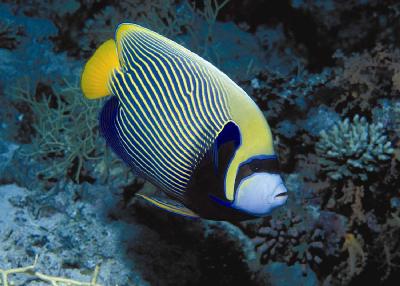April 1, 2004
Don’t flush the fish, researchers say
Flushing your pet tropical fish to set it free is a bad idea. So is releasing it at the beach.
Intentional and unintentional aquarium releases have been a leading cause of freshwater fish invasions, but now researchers from the UW and the Reef Environmental Education Foundation have found 16 non-native species of fish — apparently set free from home aquariums — in ocean waters off the southeast coast of Florida.
This is an unprecedented number of non-native marine fish in a concentrated geographic area, says Brice Semmens, a UW doctoral student in biology and lead author of a paper published in the journal Marine Ecology Progress Series.
Using data on the aquarium trade and shipping traffic, the study is the first to convincingly demonstrate that well-meaning pet owners can cause a “hot spot” of non-native tropical marine fish, Semmens says. The 16 species were found in 32 different locales along the coast of Broward and Palm Beach counties and in the upper Florida Keys. Some were in the Florida Keys National Marine Sanctuary.
Most of the species were seen at more than one place meaning more than just a few aquariums have been dumped, Semmens says. It is not clear which, if any, of the non-natives have established breeding populations, he said.
The more times a species is released, however, the greater the chance of establishment, says Walt Courtenay, fisheries biologist with the U.S. Geological Survey in Gainesville, Fla., who is known around the world for his expertise on exotic fishes. He is not a co-author of the published paper.
“Typically, I’d say aquarium owners are more concerned with the status of our marine ecosystems than the general public is, yet many appear unaware of the potential pitfalls of releasing pets into the wild,” Semmens says.
The study relied on information submitted by volunteer divers and snorkelers through the Exotic Species Sighting Program of the Reef Environmental Education Foundation, or REEF, based in Key Largo, Fla. Sightings were confirmed with photographs, video or corroboration by other divers.
The introduced species are native to the tropical western Pacific and/or Red Sea. Emperor angelfish, with their blue masks and bodies striped in blue and gold, were the most commonly sighted non-native species and are imported by the aquarium industry in relatively large numbers. Indeed, the researchers found a compelling correlation between how commonly ornamental marine species are imported and how often they were sighted. Another commonly sighted non-native was yellow tang, a bright yellow oval fish that is the most commonly imported species of the U.S. aquarium trade.
In contrast, Semmens says it is unlikely the exotics arrived in the ballast water of ships. If the fish were being introduced through ship ballast, one would expect the native ranges of the fish to correlate to where the ballast water comes from. Analyzing data on shipping traffic to Florida ports, Semmens and his co-authors found no support for this correlation.
While only a small number of introduced species might have devastating impacts, scientists are unable to predict which species will be destructive. The largest set of intentionally released marine fish was carried out in temperate coastal and inland seas of Russia in the 20th century. Sixteen species became established, with ecologically and economically devastating results, including harm to valuable fisheries, parasite introductions and the endangerment and extinction of native species.
“Releasing non-native reef fish is like playing Russian roulette with tropical marine ecosystems,” Semmens says. Then, too, even if introduced species do not have dramatic impacts, their presence is unnatural and unwanted.
“Divers visit the reefs of Florida to see the region’s natural beauty and diversity. It is a unique and magical experience to dive on these reefs. Adding new species to the region is comparable to adding a few finishing touches to one of da Vinci’s masterpieces.”
Co-authors of the paper are Eric Buhle and Anne Salomon, both UW doctoral students in biology, and Christy Pattengill-Semmens, science coordinator for the Reef Environmental Education Foundation.
Aquarium keepers need to be educated about the proper disposition of animals in their care, according to Paul Holthus, executive director and president of the Marine Aquarium Council, an international non-profit organization based in Honolulu that focuses on the way tropical fish are collected and handled before they are purchased.
“While it is against the law to release non-native marine fish into coastal waters, it’s a problem that can’t easily be policed,” Semmens says. The authors say that education programs for dealers and aquarists could curtail exotic species introductions if implemented properly. Such programs would need to highlight the problems of introduced species and provide ways for aquarium owners to sell or trade unwanted fish.
For further information, see the Web site of the Reef Environmental Education Foundation’s Exotic Species Sighting Program, http://www.reef.org/exotic/


